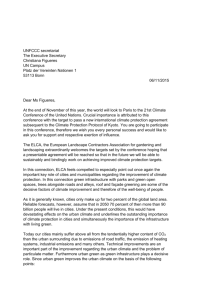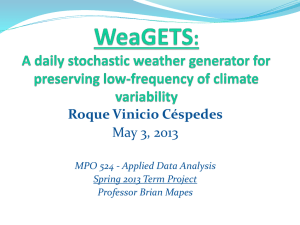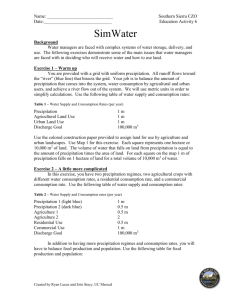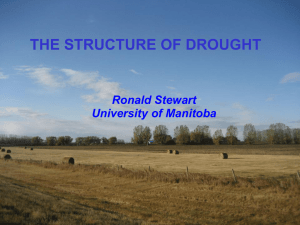mld10things
advertisement
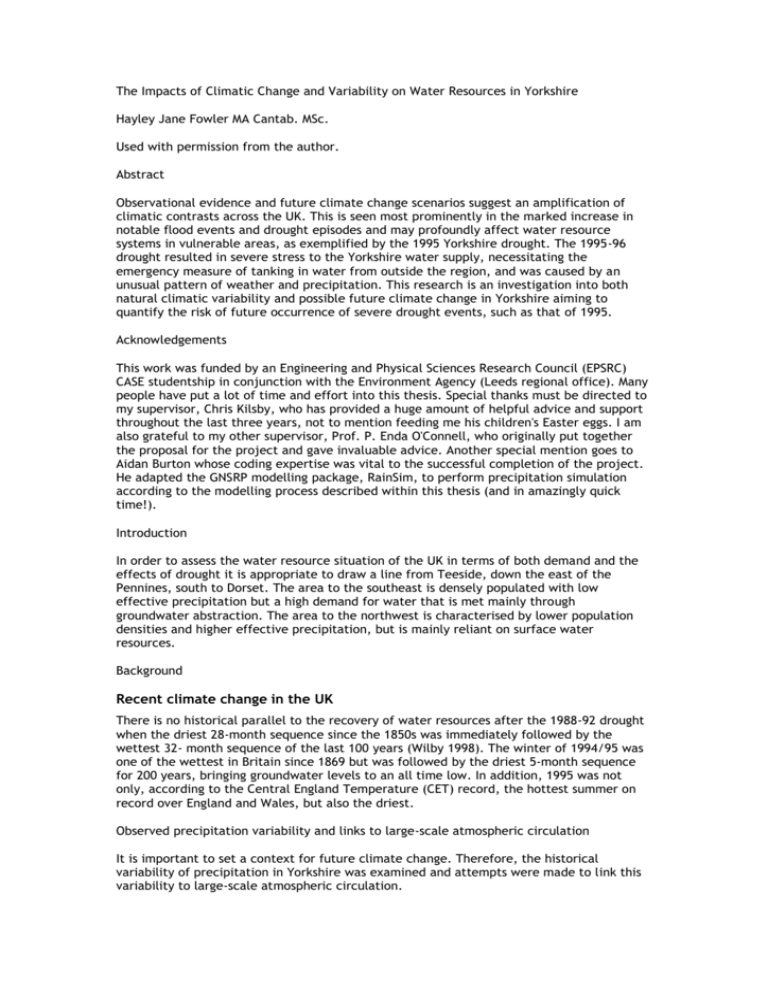
The Impacts of Climatic Change and Variability on Water Resources in Yorkshire Hayley Jane Fowler MA Cantab. MSc. Used with permission from the author. Abstract Observational evidence and future climate change scenarios suggest an amplification of climatic contrasts across the UK. This is seen most prominently in the marked increase in notable flood events and drought episodes and may profoundly affect water resource systems in vulnerable areas, as exemplified by the 1995 Yorkshire drought. The 1995-96 drought resulted in severe stress to the Yorkshire water supply, necessitating the emergency measure of tanking in water from outside the region, and was caused by an unusual pattern of weather and precipitation. This research is an investigation into both natural climatic variability and possible future climate change in Yorkshire aiming to quantify the risk of future occurrence of severe drought events, such as that of 1995. Acknowledgements This work was funded by an Engineering and Physical Sciences Research Council (EPSRC) CASE studentship in conjunction with the Environment Agency (Leeds regional office). Many people have put a lot of time and effort into this thesis. Special thanks must be directed to my supervisor, Chris Kilsby, who has provided a huge amount of helpful advice and support throughout the last three years, not to mention feeding me his children's Easter eggs. I am also grateful to my other supervisor, Prof. P. Enda O'Connell, who originally put together the proposal for the project and gave invaluable advice. Another special mention goes to Aidan Burton whose coding expertise was vital to the successful completion of the project. He adapted the GNSRP modelling package, RainSim, to perform precipitation simulation according to the modelling process described within this thesis (and in amazingly quick time!). Introduction In order to assess the water resource situation of the UK in terms of both demand and the effects of drought it is appropriate to draw a line from Teeside, down the east of the Pennines, south to Dorset. The area to the southeast is densely populated with low effective precipitation but a high demand for water that is met mainly through groundwater abstraction. The area to the northwest is characterised by lower population densities and higher effective precipitation, but is mainly reliant on surface water resources. Background Recent climate change in the UK There is no historical parallel to the recovery of water resources after the 1988-92 drought when the driest 28-month sequence since the 1850s was immediately followed by the wettest 32- month sequence of the last 100 years (Wilby 1998). The winter of 1994/95 was one of the wettest in Britain since 1869 but was followed by the driest 5-month sequence for 200 years, bringing groundwater levels to an all time low. In addition, 1995 was not only, according to the Central England Temperature (CET) record, the hottest summer on record over England and Wales, but also the driest. Observed precipitation variability and links to large-scale atmospheric circulation It is important to set a context for future climate change. Therefore, the historical variability of precipitation in Yorkshire was examined and attempts were made to link this variability to large-scale atmospheric circulation. Observed Precipitation Variability in Yorkshire The historical observed precipitation variability was examined at seven sites in Yorkshire where long daily records (50+ years) are digitally available (see FIG1 and TAB1). The longest data set is from Lockwood Reservoir in the North York Moors and is complete from 1873 to 1998, excepting 1875. Data sets were validated using the Durham precipitation series, which is regarded as accurate. The northern sites, in particular, very closely match the Durham series. TAB1. Sites in Yorkshire region where long daily precipitation records are available. Mean annual precipitation and PD given for the 1961-90 time-period. Site Location Grid. Ref Start Year Altitude (m) Missing and Suspect (%) Mean Annual Precipitation (mm) Mean Annual PD 28106 Hurry Reservoir NY 967193 1929 263 1.94 909 0.42 20408 Barnard Castle NZ 056164 1926 171 1.94 765 0.48 29156 Raby Castle NZ 668141 1929 140 8.61 812 0.45 FIG1. Sites in Yorkshire and surrounding area where long daily precipitation records are available. Fluctuations in mean daily precipitation, PD and mean wet day Seasonal variations in mean daily precipitation throughout the period from 1873-1998 show a decline in summer precipitation totals at all seven sites (see Figure 1), particularly since the 1930s. Figure 1 Summer daily precipitation (11-year centred moving average) Development of rainfall-runoff model ADM model calibration and validation Calibration methodology The parameters of the model may be interdependent, so the same values of the objective function correspond to a wide range of parameter values. The objective function may be indifferent to the values of the parameters, so that little or no change in the objective function occurs in response to appreciable changes in the value of a parameter. Discontinuities may exist in the parameter space for which the objective function is non-differentiable. Local optima may exist for which the search for a minima through an optimisation algorithm may terminate at a point on the surface of the objective function lower than those surrounding it, but higher than other points situated in another region of parameter space. The global optimum may not be found. The Nash and Sutcliffe 'efficiency' measure developed in 1970 (Nash and Sutcliffe 1970) has been adopted as a standard estimate of model accuracy and was used as the optimisation criterion for model calibration. They started with a sum of the squares criterion as shown in Equation 1. 𝐹 2 = ∑(𝑄𝑟𝑖 − 𝑄𝑠𝑖 )2 Conclusions Equation 1 The importance of taking climate change issues seriously has recently been raised by the Prime Minister, Tony Blair, following the devastating floods of autumn 2000. Planning for future climatic variability and change is now high on the political agenda. It is essential to remember, however, that this 'climate change' may simply be part of the natural variability of the climate system. Future climate in the UK will be different from that of 196 1-90, even without any human influence on the climate system. The magnitude of changes due to natural climate variability may be as great as those felt from anthropogenic effects. It is therefore essential to examine historical variability of the climate system, placing current and future climate change and variability into context. Likely future climate change impacts can then be assessed. Summary An investigation has been made into variations in the normal precipitation pattern in Yorkshire and how these may translate into impacts on the water supply system. Historical precipitation variability has been examined, to provide a context of natural climatic variability in which to view future climate change. Long-term daily precipitation records show a declining trend of summer precipitation throughout the region starting in the 1960s, coupled with an increase in winter precipitation at western sites since the 1970s. These changes can be linked to the large- scale atmospheric circulation. A high winter-NAO since the mid-1970s is likely to have caused the increase in winter precipitation at western sites. The opposite effect is observed for summer- List of Figures List of Tables List of Equations Equation 1 ................................................................................................... 3 References Nash, J. E. and J. V. Sutcliffe (1970). "River flow forecasting through conceptual models. Part I - A discussion of principles." Journal of Hydrology 10: 282-290. Wilby, R. L. (1998). "Statistical downscaling of daily precipitation using daily airflow and seasonal teleconnection indices." Climate Research 10(3): 163-178.


